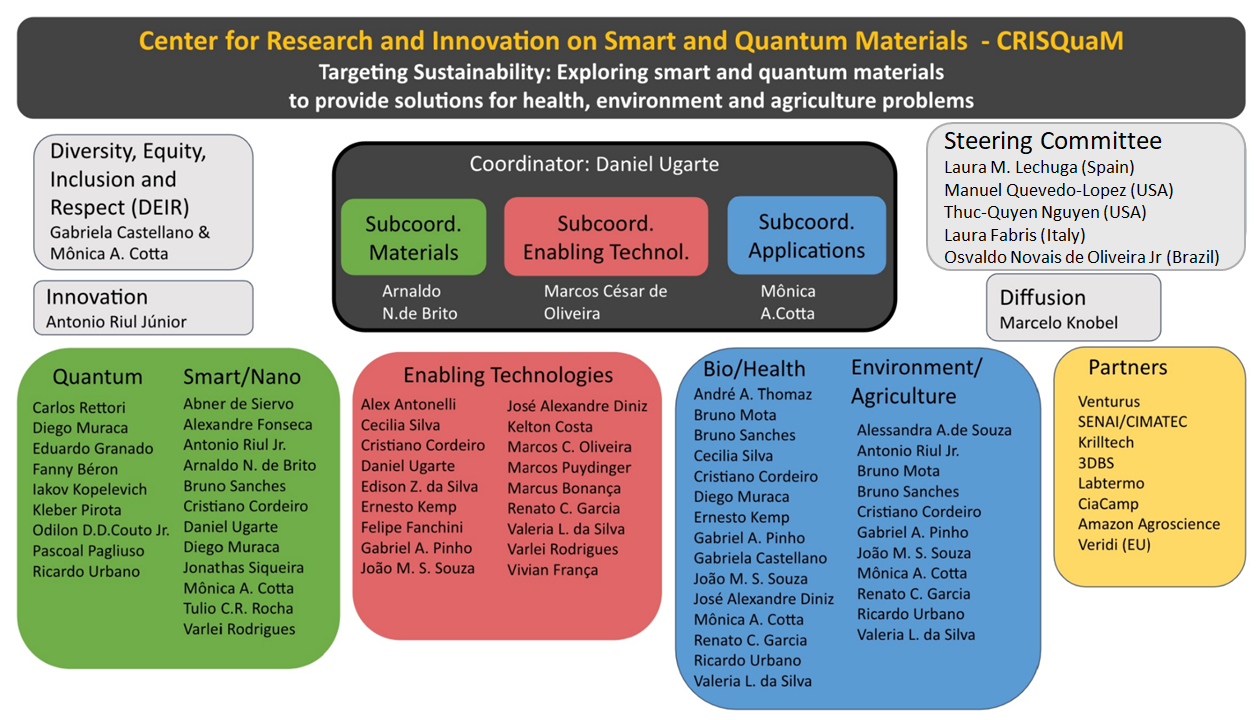BV-FAPESP: research projects supported in this Center
CRISQuaM in the Media: news about the center
CRISQuaM aims to explore the synergistic development of fundamental and applied science to create new materials with high potential for the construction of devices and sensors to address technological challenges related to sustainability, climate change, precision agriculture, ecology, and health. To achieve these goals, we have assembled an interdisciplinary and collaborative research team, integrating expertise across various scientific domains, researching novel materials with high innovation potential. By combining original synthesis methods, advanced characterization techniques, theoretical approaches, computational simulations, quantum technologies, and device construction designs, we aim to drive advances in smart and quantum materials, promoting scientific excellence and technological development. With this, we plan disruptive innovations in instrumentation—including hardware and AI-based tools—as well as in quantum technologies, biomedical devices, and signal processing, in addition to plant bionics, exploring plant-pathogen interactions. Besides research activities, we plan intensive actions in education, dissemination, and communication for the general public, as a modern society should be aware of the challenges humanity faces and how research and technology are essential for responsibly utilizing the planet's limited resources. CRISQuaM's Innovation activities are accelerated through partnerships with several companies in related technologies, many of them Brazilian. Finally, all activities of the Center are managed in accordance with diversity, equity, and inclusion goals and best practices.
The Center brings together scientists, engineers, and innovators in a collaborative effort to apply materials science and quantum technologies at the cutting edge, designing new materials and nano(bio)sensors for advanced diagnostics. The Center has a team capable of producing a wide range of (nano/micro) materials, along with precise chemical and physical characterizations using modern techniques (synchrotron, advanced microscopy, magnetotransport, magnetic resonance, optics, etc.). In addition, the team offers various options in enabling technologies, including miniaturization, processing, and additive manufacturing, as well as instrumentation, quantum sensing, and electronics development. Data analysis will employ updated approaches (numerical simulation, classical and quantum machine learning, and quantum optimization). Applications at the knowledge frontier will address urgent sustainability needs in environmental areas, precision agriculture, plant bionics, and biomedical interfaces, contributing to the development of local technologies in close partnership with the Brazilian industry.
The organization of the Center is based on three pillars — Materials, Enabling Technologies, and Applications — together with partner companies, as described in the figure below.

2024-06-07
The most abundant electric fish are found from the bottom of large rivers to igarapés, where they can bury themselves in the sand or blend into the leaf litter. In two weeks, an expedition in the Negro River basin collected 27 species of the group.
2024-06-07
One of the fishing methods used to collect electric fish in the DEGy Negro River Expedition was employed for the first time on a large scale in freshwater during the Calhamazon project, which brought together researchers from Brazil and the United States between 1993 and 1996.
2024-06-05
In tests involving animals, nanoparticles containing substances already approved for human use reduced inflammation in the biological microenvironment where malignant tumors flourish and facilitated the action of the immune system.
2024-06-05
Researchers detected SARS-CoV-2 in male reproductive cells under the microscope even when PCR testing failed to detect the virus in semen. The discovery serves as a warning of possible implications for natural conception and particularly for assisted reproduction.
2024-06-05
A startup supported by FAPESP is developing a system to assure the proper use of elements capable of guaranteeing structural integrity at high temperatures while reducing heat transfer from machinery and equipment to the environment.
2024-06-05
In the fourth 2024 FAPESP Lecture, Carlos Jaramillo, a Colombian geologist, palynologist and paleobiologist affiliated with the Smithsonian Tropical Research Institute (STRI) in Panama, showed how South America’s landscapes and biomes have evolved over geological time.
2024-06-05
In a study involving mice, scientists used a technique that combines light stimulation and bioengineering to activate a cluster of nerve cells deep inside the brain. The discovery could pave the way to future treatment of eating disorders.
2024-06-03
In experiments with mice, researchers at the State University of Campinas (UNICAMP) in Brazil and the Pasteur Institute in Lille (France) found that viral load and inflammation decreased in animals infected by influenza virus when they were given the substance.